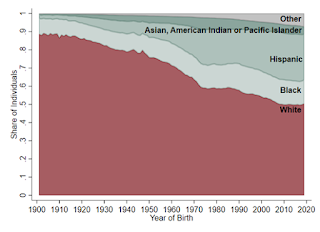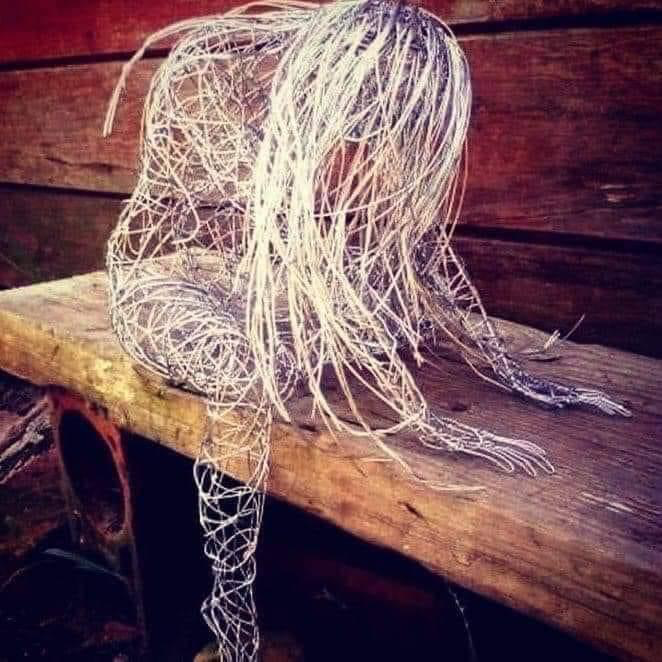Covert Mechanisms in Law, Legal, and Criminal Justice institutions
Enshrined into the fabric
of our national identity are the central values that gauge how perfect our
union is. In our founding documents, we find these words: "We hold these
truths to be self-evident that all "humans" are endowed by their
Creator with certain inalienable rights." As depicted in the figure below, our Nation
is becoming increasingly diverse. By the year 2030, it is projected that
persons of color will constitute the majority of who we are as a people. Therefore,
we must grapple with the obvert and the covert mechanisms by which these "inalienable
rights" continue to be undermined by our laws and legal and criminal
justice institutions.
Source: Treasury calculations using U.S. Census Bureau data from
IPUMS. Steven Ruggles, Sarah Flood, Sophia Foster, Ronald Goeken, Jose Pacas,
Megan Schouweiler, and Matthew Sobek. IPUMS USA: Version 11.0 [dataset].
Minneapolis, MN: IPUMS, 2021. https://doi.org/10.18128/D010.V11.0
Contrary
to our noble claims, the United States was founded on the legal,
constitutional, and practical applications of genocide against the Indigenous
natives, the enslavement of Africans, and the subjugation of multiple ethnic,
gendered, and sexualized minorities. The extent to which these legal practices
are enshrined within our society even today is seen in such things as
differential sentencing, racial profiling, gerrymandering, and the systematic
policies and procedures that continually marginalize, over-criminalize, and
incarcerate Hispanic, Indigenous, Black, and poor Americans. Consider the
disproportionately. Consider the 2021 study by the Sentencing project that
documents that Black Americans are almost five times and Latinx people 1.3
times more likely to be incarcerated than Whites in state prisons. (Nellis 2021)
Black and Latino's offenders are also more likely, in state and federal courts,
to receive longer sentences than their White counterparts in some jurisdictions.
This is more likely to impact males, even when the offenses are the same and
their criminal histories are comparable to White offenders. These disparities increase with both severity
and are even higher for juvenile offenders. (ACLU 2014)
Covert
mechanisms are at work throughout the legal and criminal system. For example,
Police are more likely to stop, search, and detain Black and Latino men
disproportionately than White males. (Kahn and Martin 2016) Research also
demonstrates that White police officers are 50 to 65 percent more likely than
black officers to use force. This use of force significantly increases as the
percentage of Black or Hispanic residents increases (Hoekstra and Sloan 2020). The
higher use of force has been linked to biased stereotypes held by White.
(Pleskac, Cesario, and Johnson 2017)
Another
covert mechanism within the legal system is the racial bias associated with
jury selection. A central feature of this bias is related to the lack of
diversity among prosecutorial offices and the judiciary. While 40 % of U.S.
citizens are persons of color, 95% of the elected prosecutors are White. Of
these, only 1.7% were Latinos (17% of the population. A total of 14 states had
no elected prosecutors who were not White. (Reflective Democracy Campaign 2014)
The judiciary similarly lacks any significant diversity. Across all states, Black,
Latino, Asian American, Native American, or multiracial only constitute 18
percent of the justices in state high courts. (Powers and Bannon, 2022)
Racial
disparities in death penalty verdicts disproportionately impact persons of
color. Since 1976, 43 % of the total executions and 55% of those currently awaiting
execution are persons of color. Although approximately one-half of all murder
victims are White, 80 percent of all Capital cases involve White victims. (ACLU
2022) These statistics hide the reality that black people are seven times more
likely than their White peers to be falsely convicted of serious crimes. This means that while blacks make up less than 14 percent of the population,
they account for 53 percent of wrongful convictions. These racial disparities occur
in all major crime categories apart from white-collar crime. Even worse are
the 2,975 additionally wrongful convictions where evidence point to the 'deliberate
framing and conviction" utilizing fabricated drug crimes where most of the
cases involved Black suspects. (Gross et al., 2022)
Rethinking
our Laws, Legal and Criminal Justice Institutions
If
we are to move forward, we cannot continue to do the same things and expect a
different result. To change the outcomes, we must change the structures and
procedures. These changes will not come overnight and reflect different
processes, not specific events. These changes must start with recognizing
that the problems are not individual or isolated but collective and systemic.
This means that what happens in one institution impacts what happens in others.
More succinctly, concentrating on one institution and one set of racial
outcomes fails to produce meaningful changes. Wealth accumulation and economic
disparities are long-term problems reflecting generations of discriminatory
practices in employment, access to loans (for investments and home purchases),
and of course, education (both access and success) and training. Systemic
changes would start with our educational system and dismantling the cradle-to-prison pipeline.
Repeated studies have reaffirmed Dewey's
assertion that we must center the educational experiences on the learner. (See
for e.g., Santi and Gorghiu 2017) Such student-centered learning means that the
learning material, pedagogies, and practices embody the various student
identities as subjects rather than as objects. Students of color often see themselves as objectified, problematized or ignored within the academic
context. Alternatively, teacher characteristics consistently are demonstrated
to impact student learning outcomes. What this means, for example, is that
Black, LGBTQ, Latino, and female teachers significantly impact Black
students. (Gershenson et al. 2017) Increasing the proportion of Black and
Latino teachers can significantly decrease the frequency of school
suspensions experienced by Latino and Black students (Shirrell, Bristol, and
Britton, 2021). Similarly, the increased presence of black police officers leads to
decreased police-involved deaths. (Pyo 2022) Increasing the diversity of juries
help to ensure that outcomes are less biased. (Seabury 2016)
These
measures will only be beginning, but in so doing, we might just be able to make
the American dream more of a reality for more of our citizens – regardless of
accidents of birth. Until then, we shall continue to (re)discover that the dream is a nightmare for too many Americans.



Comments
Post a Comment